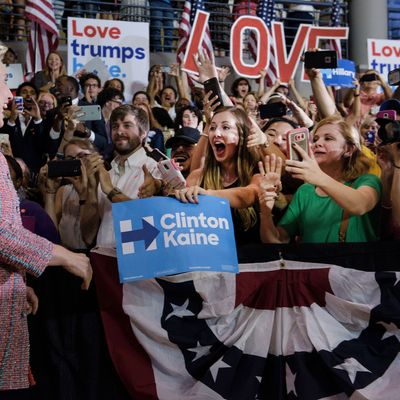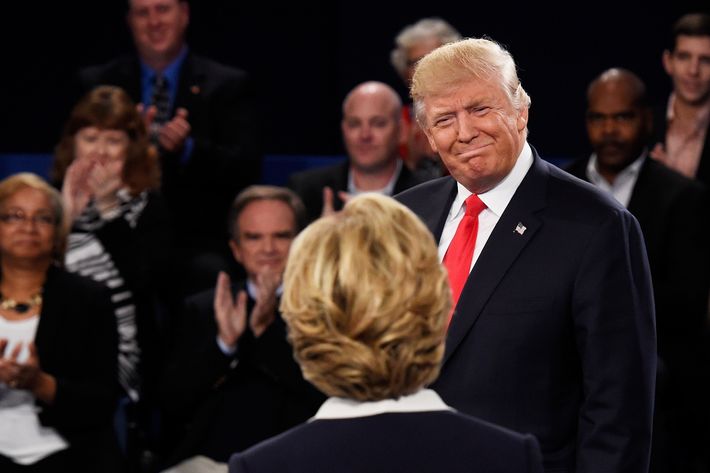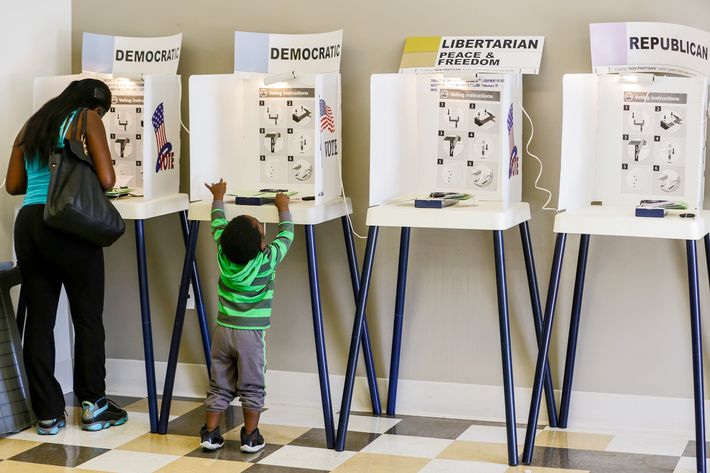
Hillary Clinton is underperforming Barack Obama among working-class whites in the upper Midwest. She isn’t quite replicating his strength among African-American voters, and early voting suggests that demographic’s turnout will be down this November (due to a combination of falling enthusiasm and rising suppression). And Clinton has struggled to generate as much support and enthusiasm among younger votes as the first black president enjoyed.
And yet, the Democratic nominee is still on pace for a decisive victory next Tuesday — because college-educated white women are plugging the gaps in the Obama coalition.
In 2012, white women with college degrees opted for Romney over Obama by 6 points, according to exit polls. In the latest Washington Post/ABC News tracking poll, they’re backing the Democratic nominee by 27 points.
That figure is on the high side — a recent Fox News poll put Clinton’s advantage with such voters at 17 percent. But there’s broad consensus in the data on the basic dynamic: College-educated white women went for the Republican four years ago; now they’re backing the Democrat by double digits.
And since this demographic is among the least likely to forget about that whole “grab ’em by the pussy” thing — and among the most likely to turn out on Election Day — they appear poised to provide Clinton’s margin of victory next week.
Which is, of course, good news for Democrats in the immediate term. But Clinton’s dependence on this traditionally Republican constituency could be a problem for Democrats in the very near future.

Donald Trump’s appeal to white-identity politics and his hard-line stance on immigration were key to his success in the Republican primary. Even Mitt Romney had to evince contempt for the undocumented to make it through that gauntlet, arguing that the government should strive to make such “illegals” so miserable, they chose to “self-deport.” In 2016, the Establishment’s golden boy Marco Rubio argued that Barack Obama was deliberately sabotaging the United States.
Which is to say: The next Republican nominee will almost certainly have some difficulty commanding significant support among nonwhite voters. Trump’s nativism and coded bigotry is central to modern GOP politics. But his cartoonish misogyny is not.
Of course, Republicans back policies that limit women’s reproductive rights and economic equality. But they don’t (usually) boast about committing sexual assault, deride women as “pigs” and slobs,” or demean female journalists with veiled references to menstruation.
A major-party nominee has never given women more reasons not to vote for him. And Trump is still winning white female voters without a college degree. If he had campaigned as a conventionally anti-feminist Republican — and thereby, retained Romney’s edge among college-educated white women — he would be on the verge of winning this election.
This should be concerning to Democrats, not least because there’s reason to think this year’s holes in the Obama coalition will remain unfilled in future cycles.
In 2008 and 2012, African-Americans turned out at higher rates than whites. Historically, the opposite has generally been true. It wouldn’t be surprising if African-American voter participation reverts to its historic mean when the singularly charismatic first black president isn’t on the ballot — especially when one of the two major parties is rewriting voting laws to facilitate that reversion.

The rightward drift of white working-class voters — who accounted for a third of all votes cast for Obama in 2012, according to the Upshot’s calculations — may also prove structural. The ongoing decline of private-sector union membership — combined with a backlash to mass immigration — seems to be driving whites without college degrees into red America’s tent.
Finally, survey data show that the rising generation of younger voters identifies less strongly with the Democratic Party than millennials just a few years their senior.
If these trends persist — and the Republican Party nominates a less grotesquely misogynistic candidate in 2020 (or beyond) — it’s easy to see how the Clinton coalition could come apart at the seams.
To be sure, there are plenty of other stories one can tell around these data points. For one thing, it’s possible that Clinton’s margins with college-educated white women reflect their enthusiasm for her candidacy more than it does their antipathy for her opponent. After all, shouldn’t we expect the first female major-party nominee to enjoy outsize support from members of her own demographic? (This view is a bit hard to square with Clinton’s unfavorable numbers, but there still may be something to it.)
What’s more, new voters are disproportionately diverse and Democratic, suggesting that every four years Team Blue’s base should grow larger relative to the GOP’s. Plus, looking beyond 2020, it seems likely that the next Democratic standard-bearer will have the benefit of not being under FBI investigation.
Regardless, Democrats have reason to worry about their ability to retain college-educated white women in the post-Trump world — assuming such voters deliver us to that realm next Tuesday.






























